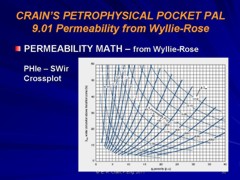|
 PERMEABILITY
from Dumanoir and Coates
PERMEABILITY
from Dumanoir and Coates
The
original model is somewhat complicated and not very accurate
in water bearing zones due to a number of assumptions that
need to be made. The simplofied model is popular because it
treats the porosity in the same way as the dual-water
saturation model. Both total and effective porosity are
used, so there is an implicit shale correction to the
permeability calculation.
First
find the resistivity log reading in the irreducible water zone:
1: IF Sw > 0.70
2: THEN SWir = KBUCKL / PHIe
3: AND RESir = A * RW@FT / (PHIe ^ M) / (SWir ^ N)
4: OTHERWISE RESir = RESD
Then
calculate the porosity exponent (LPERM)
5: LPERM = (3.75 - PHIe + ((log (RW@FT / RESir) + 2.2) ^ 2) /
2) ^ 0.5
And
finally:
6: PERMd = LPERM * ( 0.077 + 1.55 * DENShy - 0.627 * DENShy ^
2)
* (PHIe ^ (2 * LPERM)) / ((LPERM ^ 4) * (RW@FT / RESir))) ^ 2
Where:
A = tortuosity exponent (fractional)
KPERM = permeability constant (fractional)
LPERM = porosity exponent (fractional)
DENShy = hydrocarbon density (gm/cc)
M = cementation exponent (fractional)
N = saturation exponent (fractional)
PERMd = calculated permeability (millidarcies)
PHIe = effective porosity (fractional)
KBUCKL = porosity saturation product (fractional)
RESD = resistivity log reading (ohm-m)
RESir = resistivity at irreducible water saturation (ohm-m)
RW@FT = water resistivity at formation temperature (ohm-m)
Sw = water saturation (fractional)
SWir = irreducible water saturation (fractional)
 COMMENTS:
COMMENTS:
Reference:
1. A New Approach to Improved Log Derived Permeability,
G.R. Coates, J.L. Dumanoir, SPWLA, 1973.
This complex formula does not lend itself to graphical solution,
although some charts are provided in the original technical paper.
A simpler version of this algorithm can be found below.
 RECOMMENDED
PARAMETERS:
RECOMMENDED
PARAMETERS:
KPERM is usually set at 90,000, but can be modified with local
experience.
 NUMERICAL
EXAMPLE
NUMERICAL
EXAMPLE
Assume data from Classic Example Sand B.
PHIe = 0.30
RW@FT = 0.02 ohm-m
A = 0.62
M = 2.15
SWir = Sw = 0.25
RESD = 20 ohm-m
N = 2.00
DENShy = 0.8 gm/cc
Dumanoir and Coates method:
KPERM = 90,000
LPERM = (3.75 - 0.30 + ((log (0.2 / 20) + 2.2) ^ 2) / 2) ^ 0.5
= 1.86
PERMd = 90,000*(0.077+1.55*0.8-0.627*0.8*0.8)*(0.3^(2*1.86)) /
((1.86^4)*(0.2/20)))^2
PERMd = 90,000 * (0.915 * 0.0
 Permeability From the Coates Simplified Method
Permeability From the Coates Simplified Method
 PERMc - Permeability From the Coates Simplified Method
PERMc - Permeability From the Coates Simplified Method
This
is a simplification of an earlier method proposed by Dumanoir
and Coates. It is more optimistic than other methods in low porosity.
7: PERMc = GPERM * PHIe ^ 4 * ((PHIt - PHIe * SWir) / (PHIe *
SWir)) ^ 2
OR
in clean zones:
8: PERMc = GPERM * PHIe ^ 4 * ((1 - SWir) / SWir) ^ 2
Where:
GPERM = permeability scale factor (fractional)
PERMc = calculated permeability (millidarcies)
PHIe = effective porosity (fractional)
PHIt = total porosity (fractional)
SWir = irreducible water saturation (fractional)
 COMMENTS:
COMMENTS:
This method works well in shaly sands. As the difference between
PHIt and PHIe increases, PERMc decreases.
 RECOMMENDED
PARAMETERS:
RECOMMENDED
PARAMETERS:
GPERM = 6500 to 10000 for oil, 650 to 1000 for gas
 META/LOG "PERM" Compare
Permeability Calculated from Various Methods
META/LOG "PERM" Compare
Permeability Calculated from Various Methods
Download this spreadsheet:
SPR-24 META/LOG PERMEABILITY CALCULATOR
Calculate and compare permeability derived from well
logs,
5 Methods.
|


